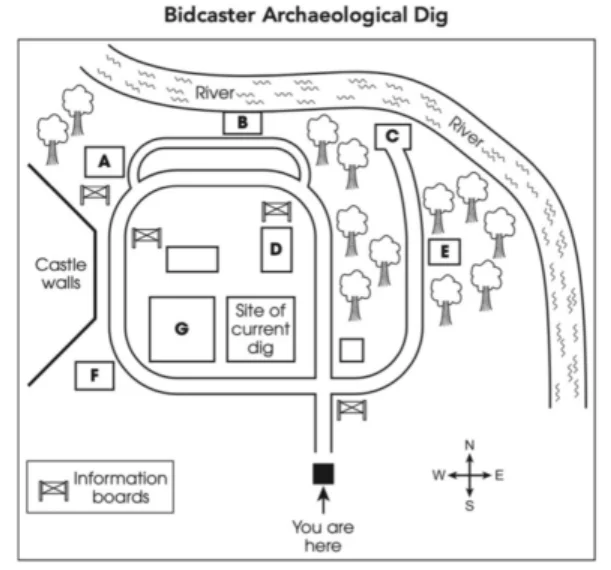Part 1: Questions 1-10
Complete the table below. Write ONE WORD AND/ OR A NUMBER for each answer.
| Furniture Rental Companies | ||
| Name of company | Information about costs | Additional notes |
| Peak Rentals | Price ranges from $105 to $ (1) per room per month | The furniture is very (2)
Delivers in 1-2 days
Special offer: Free (3) with every living room set
|
| (4) And Oliver | Mid-range prices
12% monthly fee for (5)
| Also offers a cleaning service |
| Larch Furniture | Offers cheapest process for renting furniture and (6) items | Must have own (7)
Minimum contract length: Six months
|
| (8) Rentals | See the (9) for the most up-to-date prices | (10) are allowed within 7 days of delivery |
Part 2: Questions 11 – 16
Choose the correct letter, A, B or C.
11. Who was responsible for starting the community project?
A the castle owners
B a national charity
C the local council
12. How was the gold coin found?
A Heavy rain had removed some of the soil.
B The ground was dug up by wild rabbits.
C A person with a metal detector searched the area.
13. What led the archaeologists to believe there was an ancient village on this site?
A the lucky discovery of old records
B the bases of several structures visible in the grass
C the unusual stones found near the castle
14. What are the team still hoping to find?
A everyday pottery
B animal bones
C pieces of jewellery
15. What was found on the other side of the river to the castle?
A the remains of a large palace
B the outline of fields
C a number of small huts
16. What do the team plan to do after work ends this summer?
A prepare a display for a museum
B take part in a television programme
C start to organise school visits
Questions 17 – 20
Label the map below. Write the correct letter A-G next to questions 17-20.

17
18
19
20
Part 3: Questions 21 – 26
Choose the correct letter, A, B or C.
21. Finn was pleased to discover that their topic
A was not familiar to their module leader.
B had not been chosen by other students.
C did not prove to be difficult to research.
22. Maya says a mistaken belief about theatre programmes is that
A theatres pay companies to produce them.
B few theatre-goers buy them nowadays.
C they contain far more adverts than previously.
23. Finn was surprised that, in early British theatre, programmes
A were difficult for audiences to obtain.
B were given out free of charge.
C were seen as a kind of contract.
24. Maya feels their project should include an explanation of why companies of actors
A promoted their own plays.
B performed plays outdoors.
C had to tour with their plays.
25. Finn and Maya both think that, compared to nineteenth-century programmes, those from the eighteenth century
A were more original.
B were more colourful.
C were more informative.
26. Maya doesn’t fully understand why, in the twentieth century,
A very few theatre programmes were printed in the USA.
B British theatre programmes failed to develop for so long.
C theatre programmes in Britain copied fashions from the USA.
Questions 27-30
What comment is made about the programme for each of the following shows? Choose FOUR answers from the box and write the correct letter, A-F, next to Questions 27-30.
Show
Ruy Bias (27)
Man of La Mancha (28)
The Tragedy of Jane Shore (29)
The Sailors’ Festival (30)
Comment about programme
A Its origin is somewhat controversial.
B It is historically significant for a country.
C It was effective at attracting audiences.
D It is included in a recent project.
E It contains insights into the show.
F It resembles an artwork.
Part 4: Questions 31 – 40
Complete the notes below. Write ONE WORD ONLY for each answer.
Inclusive design
Definition
• Designing products that can be accessed by a diverse range of people without the need for any (31)
• Not the same as universal design: that is design for everyone, including catering for people with (32) problems.
Examples of inclusive design
• (33) which are adjustable, avoiding back or neck problems
• (34) in public toilets which are easier to use
• To assist the elderly:
o designers avoid using (35) in interfaces
o people can make commands using a mouse, keyboard or their (36)
Impact of non-inclusive designs
• Access
o Loss of independence for disabled people.
• Safety
o Seatbelts are especially problematic for (37) women.
o PPE Jackets are often unsuitable because of the size of women’s (38)
o PPE for female (39) officers dealing with emergencies is the worst.
• Comfort in the workplace
o The (40) in offices is often too tow for women.